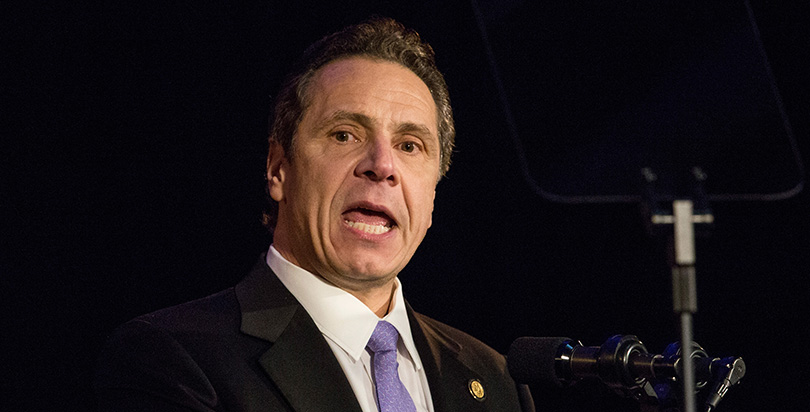Updated, April 10: New York Gov. Andrew Cuomo announced a new $153.1 billion budget last Friday, a week after its April 1 deadline. The headline items include free tuition at state public colleges for students whose parents earn less than $125,000 and a provision that would establish 18 as the age when young people can be tried as adults — up from the current minimum of 16.
Cuomo also boosted spending on education to $1.1 billion, an increase of 4.4 percent, while charters will receive a boost in rental assistance and spending this year — and will receive the same increases in the future as traditional schools do. The cap on charter schools remained in place.
A one-year extension of mayoral control in New York City was pulled from consideration. Senate Republicans, who have oppose Mayor Bill de Blasio since he campaigned against them in 2016, want to revisit the issue later in the spring.
As New York lawmakers work to reach a budget that was due Friday — with school districts, which have to file budgets soon, watching closely — two school funding lawsuits that could transform future budgets are making their way through state court.
Both cases stem from the landmark Campaign for Fiscal Equity ruling in 2006, which led to a new formula for calculating school aid and a pledge of $7 billion by then-Gov. Eliot Spitzer. When the recession hit two years later, however, funding was sharply curtailed. Ever since, plaintiffs in both cases argue, the state has neglected its constitutional obligation to adequately fund schools and ensure that all students get a “sound basic education.”
“Basically, we’ve been living with the state not living up to its obligations under the [CFE] formula since 2009, 2010,” said Michael Rebell, an educational law scholar at Teachers College, Columbia University, who litigated the CFE case. “I think the constitutional law is clear that kids’ rights don’t go on hold because of the state’s fiscal constraints.”
On May 30, Rebell will argue on behalf of New Yorkers for Students’ Educational Rights, or NYSER, a CFE offshoot that claims the state never fulfilled what was promised 10 years ago.
Rebell and other advocates say there’s still a $4.3 billion gap between what the formula calls for and what’s been provided statewide.
NYSER plaintiffs include 26 parents and students backed by school boards, several New York City Community Education Councils, and other stakeholders across the state.
A state Supreme Court judge upheld the case last year; the state says in an appeal filed March 15 that plaintiffs can’t show all districts statewide have been shortchanged. It argues as well that CFE only applied to New York City and established a framework or guidelines, rather than an explicit “constitutional minimum,” for state funding.
In the other lawsuit, Maisto v. New York (known as the “Small Cities” case), eight school districts argue that the state owes them millions more under CFE due to their “intense poverty” and low property wealth.
The districts educate about 55,000 students and are collectively short $140 million in state aid under the formula, said Robert Biggerstaff, attorney for the plaintiffs. The result, he says, is worse performance among the state’s most vulnerable student populations, including poor, black, and Hispanic children, as well as refugees.
The complaint was brought by substantially low-income districts including Jamestown, Kingston, Mount Vernon, Newburgh, Niagara Falls, Port Jervis, Poughkeepsie, and Utica. A New York state Supreme Court judge dismissed the claims in September 2016; plaintiffs’ appeal could be heard as soon as September, Biggerstaff said.
He believes that a favorable NYSER decision could affect the Maisto outcome by “alerting everyone in the education community and also in the judiciary of the continued viability of the CFE case.”
“If we’re not successful,” he added, “it’s going to destroy 30 years of court of appeals decisions in this state supporting the proposition that children are entitled to a meaningful high school education, and it’s going to eviscerate the education article [in the state constitution] of any meaning.”
Cuomo rejects the argument that the state is legally obligated by CFE, and proposed a $1 billion increase in school aid for 2017–18. New York spends more than any other state per student in public schools — an average $20,610 per student, compared with $11,009 nationally, according to 2016 census data.
At the same time, spending disparity between wealthy and poor districts has grown, a 2016 report from the New York State Association of School Business Officials shows. On average, rich schools spend $23,000, while poor ones spend $17,200, The Journal News reported.
Cuomo says he will improve the formula by updating the student poverty data used, which advocates commend but believe is not enough to create an “equitable, predictable, adequate, and sustainable” long-term funding mechanism, said Rick Timbs, executive director of the Statewide School Finance Consortium, a plaintiff in the NYSER case.
“We can’t have this ‘Let’s make up something’ every year,” he said. “What we really need is a rational analysis and discussion, a comparison of where we’ve been and where we’re going. You’d think after 10 years we could have done better.”
Get stories like these delivered straight to your inbox. Sign up for The 74 Newsletter


;)
